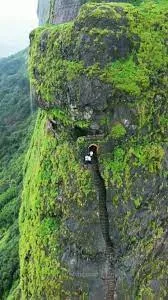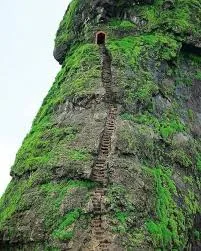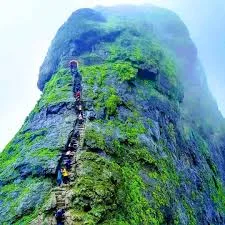Harihar Fort, also known as Harshagad, stands as a testament to ancient engineering and strategic brilliance in Maharashtra’s Nashik district, located 40 km from Nashik City, 48 km from Igatpuri, and 40 km from Ghoti. Built during the Seuna (Yadava) dynasty (9th–13th centuries), this hill fort, perched at 3,676 feet (1,120 meters) in the Trymbak Range, was designed to guard the vital Gonda Ghat trade route. Its unique triangular prism shape, near-vertical cliffs, and iconic rock-cut staircase make it a magnet for trekkers and history enthusiasts, offering a blend of adrenaline and historical intrigue.

Historical Significance
Constructed under the Yadava dynasty, Harihar Fort was a key stronghold overlooking trade routes connecting Maharashtra to Gujarat. Its strategic position made it a prized asset, changing hands over centuries. In 1636, it was surrendered to Mughal commander Khan Zamam alongside Trymbak and other Pune forts. By 1818, British forces under Captain Briggs captured it, along with 17 other forts, during the Maratha resistance’s decline. The fort’s name, derived from the deities Hari (Vishnu) and Har (Shiva), reflects its cultural significance, possibly symbolizing a syncretic spiritual identity.

Architectural Marvel
From its base villages—Harshewadi or Nirgudpada—the fort appears rectangular but is built on a triangular prism of rock, with three faces and two edges at a sheer 90-degree angle and a western edge inclined at 75 degrees. This geometry, leveraging natural cliffs, made Harihar nearly impregnable. The fort’s defining feature is its one-meter-wide rock-cut staircase, comprising 117 steep, narrow steps carved into the cliff face, complete with handholds and niches for grip. The climb involves multiple stages: an initial ascent from the base, a traverse beneath an overhang with a sheer drop, a second set of steeper steps, and a final staircase carved inside the rock leading to the summit.

At the top, the fort’s ruins include a storage house, eight rock-cut water cisterns, a small Hanuman and Shiva temple with a Nandi idol, and a freshwater pond. The summit offers panoramic views of peaks like Brahmagiri, Basgad, Anjaneri, and Feni, rewarding climbers with a breathtaking vista of the Sahyadri range.

The Trek: A Test of Nerve and Endurance
The trek to Harihar Fort, starting from Nirgudpada (40 km from Ghoti) or Harshewadi (13 km from Trymbakeshwar), is rated moderate to challenging, taking 1.5–2.5 hours to ascend. Nirgudpada offers a shorter, more adventurous route with the signature rock steps, while Harshewadi provides a gentler ascent through scrub forests before merging with the main climb. The 117 steps, often at 75–90-degree inclines, are narrow and worn, requiring focus and balance, especially in monsoon when they turn slippery. The path’s exposed sections, like the overhang traverse, demand caution, with no railings and sheer drops below.
Logistics:
Access: From Mumbai (160–200 km, 4–5 hours by road) or Pune (240 km, 5–6 hours), reach Nashik or Igatpuri via train or bus, then take local transport to Nirgudpada or Harshewadi. The last bus from Trymbakeshwar to Ghoti departs at 5:30 PM.
Best Time: October to February for clear skies and mild weather (15–25°C). Monsoon (June–September) offers lush scenery but risky, slippery steps. Avoid summer (March–May) due to heat and dehydration risks.
Gear: Trekking shoes with good grip, 2–3 liters of water, snacks, and a light backpack. Trekking poles help on steep sections.

Lessons from the Amazons: Empowerment and Resilience
While the query references the Dahomey Amazons, it seems unrelated to Harihar Fort. However, we can draw parallels to the fort’s enduring legacy as a symbol of resilience and strategic ingenuity, much like the Amazons’ courage. The fort’s builders, facing rugged terrain and threats, crafted a near-unassailable stronghold, reflecting adaptability and determination. Modern lessons from Harihar include:

Overcoming Challenges: The steep climb teaches perseverance, encouraging us to tackle daunting tasks with preparation and focus, much like the Amazons’ rigorous training.
Embracing Heritage: The fort’s cultural and historical significance inspires pride in local traditions, urging us to preserve and learn from our past, akin to reclaiming the Amazons’ narrative.
Community Effort: Just as the Amazons thrived through sisterhood, group treks to Harihar foster teamwork, emphasizing collective support in achieving goals.
A Living Legacy

Harihar Fort’s blend of history, architecture, and adventure makes it a captivating destination. Its rock-cut stairs, once a defensive marvel, now challenge trekkers to conquer their fears, while its ruins whisper tales of a bygone era. As one of Maharashtra’s iconic forts, it invites exploration and reflection, reminding us of the ingenuity of those who built it and the resilience needed to scale its heights. Whether for the thrill of the climb or the allure of history, Harihar remains a monument to human tenacity, beckoning adventurers to tread its ancient steps.





